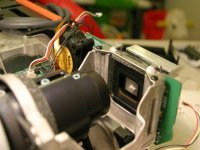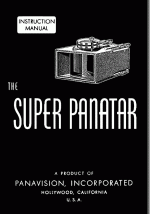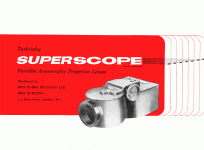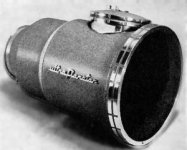First, thank you ALL for the insight, testing, and determination. You have inspired me to think about getting a DLP, and building my own lens.
I hope the following info will be useful, and not disruptive.
Recently, I had the opportunity to set up a Runco VX-5c W/ the Anamorphic lens. Here are some of my observations:
~The lens has a crown at the projector side (raised at the center), to compensate for the bowing/pincushion at the top and bottom of the image.
~It has a focus ring to compensate for focus consistency at the outer edges.
~Rotating the lens causes/corrects the trapezoid effect.
~Tilting the lens (fwd/back) evens out the bowing/pincushion between the top and bottom edges of the image. Once adjusted, the angle is approx the same as the angle of the beam from the projector.
~The manufacturer recommends setting up the projector (in 4x3)
without the lens first to get the angle/keystone of the projector correct, then add the lens & set up again.
Keep up the good work!! 😀
I hope the following info will be useful, and not disruptive.
Recently, I had the opportunity to set up a Runco VX-5c W/ the Anamorphic lens. Here are some of my observations:
~The lens has a crown at the projector side (raised at the center), to compensate for the bowing/pincushion at the top and bottom of the image.
~It has a focus ring to compensate for focus consistency at the outer edges.
~Rotating the lens causes/corrects the trapezoid effect.
~Tilting the lens (fwd/back) evens out the bowing/pincushion between the top and bottom edges of the image. Once adjusted, the angle is approx the same as the angle of the beam from the projector.
~The manufacturer recommends setting up the projector (in 4x3)
without the lens first to get the angle/keystone of the projector correct, then add the lens & set up again.
Keep up the good work!! 😀
Hmmm,
A thought just occurred to me........
Why not use Black RTV Automotive Silicone to seal the prisms?
It's oil & gasoline resistant, and therefore would be safe for use with turpentine, mineral oil, glycerin, and (of course) water.
It's available at any automotive parts store 🙂
A thought just occurred to me........
Why not use Black RTV Automotive Silicone to seal the prisms?
It's oil & gasoline resistant, and therefore would be safe for use with turpentine, mineral oil, glycerin, and (of course) water.
It's available at any automotive parts store 🙂
I wanna try making a glycerol lense now. I saw some pictures of the Optimorph lense for my NEC HT1000 here:
http://www.avsforum.com/avs-vb/showthread.php?s=&threadid=334127
http://www.avsforum.com/avs-vb/showthread.php?s=&threadid=334127
Hi Guys
I have follow through this thread for a while.
Finally I got time to disassemble my HT1000 and I notice something worth trying for another DIY anamorphic lens project.
DLP projector utilize different light engine and I can add a rear attachment to the lens.
Yes! that is exactly what I want to do. I want to make a anamorphic lens and put it at the rear end of the projector lens.
The lens will be about 1" in length and width, so it is fairly inexpensive to use solid optical grade prism for this anamorphic lens.
as the attached photo, I opened up my HT1000 and do some observation.
any one knows any place I can get good glass prism about 1" in height?
I have follow through this thread for a while.
Finally I got time to disassemble my HT1000 and I notice something worth trying for another DIY anamorphic lens project.
DLP projector utilize different light engine and I can add a rear attachment to the lens.
Yes! that is exactly what I want to do. I want to make a anamorphic lens and put it at the rear end of the projector lens.
The lens will be about 1" in length and width, so it is fairly inexpensive to use solid optical grade prism for this anamorphic lens.
as the attached photo, I opened up my HT1000 and do some observation.
any one knows any place I can get good glass prism about 1" in height?
Attachments
Angle and Prism calculation
After some review of basic refraction principles, I made a spreadsheet for calculating prism angle and angle between two prism. You can adjust the refractive indice number as well.
As for 2.35:1 compressionIf using glass prisms(30,60,90), the angle between the two prism is around 49 degrees.
After some review of basic refraction principles, I made a spreadsheet for calculating prism angle and angle between two prism. You can adjust the refractive indice number as well.
As for 2.35:1 compressionIf using glass prisms(30,60,90), the angle between the two prism is around 49 degrees.
This is my first post to this forum so be gentle. I recently set out to build an anamorphis lens to stretch the image from my native 16:9 projector to 2.35:1 so I could watch scope movies with no black bars or wasted panel resolution. I used the water and mineral oil design from the beginning of this thread and I must say it has worked out much better than I thought. I used picture from glass for every part of the two prisms and silicone for the seams. Cutting the glass was a bit tricky but doable with a little patience. Getting the prisms sealed was a bit more of a challenge as I kept getting leaks in the oil prism. When finished...just last night, I mounted the lens in fron of my PJ on a shelf and voila...2.35:1 widescreen beauty...well, not quite. I think I am a bit shy of 2.35, more like 2.20 or 2.25, but good enough for my first. The image has perfect focus, but the geometry is a bit off. There is a wee bit of vertical keystoning, but it is not distracting when I actually watch a movie and a but of barrel distortion on the bottom no doubt due to the short throw of my PJ. These anomalies are trivial compared to watching a 127" wide image that is smooth and sharp at the same time. I have an LCD so I defocus a bit and I figured the lens would blur things up, but quite the contrary, it sharpened the image up with no more pixel grid texture than without it...nice. Thanks to all that have contributed to this thread...I will more than likely make another lens with smaller prisms and better non reflective glass...but not yet...I need to watch somemore scope movies first.
Bricktop
Bricktop
I did notice something else and I wonder if this has been noticed by others...the stretch is not even across the screen. It appears the sides have a bit more stretch than the middle. I am thinking again that this has something to do with the shorth throw lens and the images angle of incidence onto the prisms. Anybody?
Bricktop
Bricktop
Stretch
Sorry Bricktop, even on current top of the range Panavision lenses the stretch is not 100% even, but it is not a problem as there are unofficial standards that lenses on 35/65mm cameras and optical printers conform to, so the compression and stretch effects are evened out.
Basically, the lens on the camera compresses, in a non uniform way, but the lens on the projector also expands the image in the same non uniform way, so it evens out.
As for using prisms, that's how the origional anamorphic lenses for the 'Ultra Panavision' system for 65mm cameras worked. Sorry, i'm a film man, not a digital domain man. Prisms were used at first in the 1950's because of these reasons: 'Anamorphic compression and expansion can be achieved through many different optical schemes. Panavision's initial work began with prisms, which have certain optical advantages over lenses (e.g. cheap to make and design) and may offer adjustment in projection, but they are generally much larger.'
Here's a link to a page about the origional lens: http://www.widescreenmuseum.com/widescreen/wingup2.htm
They worked well, but did not have even compression across the whole field. They were used because the compression factor could be changed easilly.
Another point, I may be wrong here, but are most of you putting your anamorphic lenses between the led ect and the lens, if so you should not do this. Anamorphic lenses should be fixed onto the end of your prime lens. E.g. LIGHT SOURCE --> LED --> USUAL LENS --> anamorphic lens --> Screen, never before the Usual lens!!!
If anyone wants anymore info on anamorphic lenses with regard, just post a message, I will try and help, considder that I have only had ecperiece with 35mm/16mm Movie Cameras and Projectors, the the theory is the same.
the stretch is not even across the screen
Sorry Bricktop, even on current top of the range Panavision lenses the stretch is not 100% even, but it is not a problem as there are unofficial standards that lenses on 35/65mm cameras and optical printers conform to, so the compression and stretch effects are evened out.
Basically, the lens on the camera compresses, in a non uniform way, but the lens on the projector also expands the image in the same non uniform way, so it evens out.
As for using prisms, that's how the origional anamorphic lenses for the 'Ultra Panavision' system for 65mm cameras worked. Sorry, i'm a film man, not a digital domain man. Prisms were used at first in the 1950's because of these reasons: 'Anamorphic compression and expansion can be achieved through many different optical schemes. Panavision's initial work began with prisms, which have certain optical advantages over lenses (e.g. cheap to make and design) and may offer adjustment in projection, but they are generally much larger.'
Here's a link to a page about the origional lens: http://www.widescreenmuseum.com/widescreen/wingup2.htm
They worked well, but did not have even compression across the whole field. They were used because the compression factor could be changed easilly.
Another point, I may be wrong here, but are most of you putting your anamorphic lenses between the led ect and the lens, if so you should not do this. Anamorphic lenses should be fixed onto the end of your prime lens. E.g. LIGHT SOURCE --> LED --> USUAL LENS --> anamorphic lens --> Screen, never before the Usual lens!!!
If anyone wants anymore info on anamorphic lenses with regard, just post a message, I will try and help, considder that I have only had ecperiece with 35mm/16mm Movie Cameras and Projectors, the the theory is the same.
As for 2.35:1 compressionIf using glass prisms(30,60,90), the angle between the two prism is around 49 degrees.
What do you mean 30,60,90)? What does this refer to?
Also the prisms can be made out of glass correct? Especially if I use glycerin for both correct?
This is interesting, but it makes me curious...
I understand how an anomorphic prism makes the image smaller, and I understand why this can create chromatic abberation (i have a telescope, so Im a little familiar) but what Im curious of, is why wouldnt a curve surface mirror work?
I understand that if this even worked, it would only work for people who use a mirror, but would it even work at all? Just curious.... as this would alliviate a lot of problems, such as chromatic abberation, and possible rainbows and keystoning... etc etc etc....
The reason Im asking, is because if this could be solved with a mirror, then it would seem that the mirror could simple be switched from a flat one for 4:3 to a curved one for 16:9
Just curious... thats all...
I understand how an anomorphic prism makes the image smaller, and I understand why this can create chromatic abberation (i have a telescope, so Im a little familiar) but what Im curious of, is why wouldnt a curve surface mirror work?
An externally hosted image should be here but it was not working when we last tested it.
I understand that if this even worked, it would only work for people who use a mirror, but would it even work at all? Just curious.... as this would alliviate a lot of problems, such as chromatic abberation, and possible rainbows and keystoning... etc etc etc....
The reason Im asking, is because if this could be solved with a mirror, then it would seem that the mirror could simple be switched from a flat one for 4:3 to a curved one for 16:9
Just curious... thats all...
I think the curved surface reflection will work. the problem is how to obtain the correct curved mirror?
Using reflection to perform verticle compression is the same principle of refraction.
You will need two curved mirrors, one concave, one convex.
You can even achieve 4:3 to 2.35:1.
I've thought about it, but I need to get good quality curved mirror in the first place.
NEC WT600 uses mirrors rather than lens for its light engine. I think this is a cheaper way to get DIY anamorphic lens.NEC WT600
Using reflection to perform verticle compression is the same principle of refraction.
You will need two curved mirrors, one concave, one convex.
You can even achieve 4:3 to 2.35:1.
I've thought about it, but I need to get good quality curved mirror in the first place.
NEC WT600 uses mirrors rather than lens for its light engine. I think this is a cheaper way to get DIY anamorphic lens.NEC WT600
amra
you will get in trouble with the sharpness of your projected picture. the curved mirror will bring parts of the picture out of focus so you will have blurred parts of the image... the prisms do only compress the rays to a smaller area because of the refraction of the different liquids in the prisms but doesn't shorten or lenghten it...
you will get in trouble with the sharpness of your projected picture. the curved mirror will bring parts of the picture out of focus so you will have blurred parts of the image... the prisms do only compress the rays to a smaller area because of the refraction of the different liquids in the prisms but doesn't shorten or lenghten it...
I think Amra's design is good though.
A concaved mirror acts like a cylindrical convex lens, it will compress the incident light beam. As long as the lens after the mirror is a cylindrical concave lens, Vertical compression is possible.
I am designing a convex, concave mirror system to act as a anamorphic lens. I will use a CNC to get the curvature right.
A concaved mirror acts like a cylindrical convex lens, it will compress the incident light beam. As long as the lens after the mirror is a cylindrical concave lens, Vertical compression is possible.
I am designing a convex, concave mirror system to act as a anamorphic lens. I will use a CNC to get the curvature right.
Building a variable anamophic lens
Have any of you guys out there thought of trying to recreate on a lightweight scale a variable anamorphic lens system like the old superscopes or panatar. I think something like this implimented in lighter weight plastic would be the perfect projector solution.
It seems to me that all they do is tilt the prisms both at the same time on a central axis to vary the compression.
I think the hardest part would be to get the prisms of the right material to cancel out abberations. As this picture shows the prisms seem to be of a doublet type of configuration. With differing index of refraction.
Hezz
Have any of you guys out there thought of trying to recreate on a lightweight scale a variable anamorphic lens system like the old superscopes or panatar. I think something like this implimented in lighter weight plastic would be the perfect projector solution.
It seems to me that all they do is tilt the prisms both at the same time on a central axis to vary the compression.
I think the hardest part would be to get the prisms of the right material to cancel out abberations. As this picture shows the prisms seem to be of a doublet type of configuration. With differing index of refraction.
Hezz
Attachments
- Home
- General Interest
- Everything Else
- The Moving Image
- Optics
- DIY anamorphic lens




